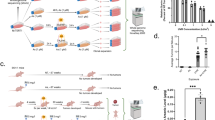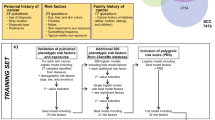Severe sunburn in newborn, but not adult, mice is linked with melanoma in later life.
Abstract
Retrospective epidemiological data have indicated that cutaneous malignant melanoma may arise as a consequence of intense, intermittent exposure of the skin to ultraviolet radiation, particularly in children, rather than from the cumulative lifetime exposure that is associated with other forms of skin cancer1,2,3. Here we use a genetically engineered mouse model to show that a single dose of burning ultraviolet radiation to neonates, but not adults, is necessary and sufficient to induce tumours with high penetrance which are reminiscent of human melanoma. Our results provide experimental support for epidemiological evidence that childhood sunburn poses a significant risk of developing this potentially fatal disease.
This is a preview of subscription content, access via your institution
Access options
Subscribe to this journal
Receive 51 print issues and online access
$199.00 per year
only $3.90 per issue
Buy this article
- Purchase on Springer Link
- Instant access to full article PDF
Prices may be subject to local taxes which are calculated during checkout

Similar content being viewed by others
References
Holman, C. D. J., Armstrong, B. K. & Heenan, P. J. J. Natl Cancer Inst. 71, 651–656 (1983).
International Agency for Research on Cancer. IARC Monogr. 55(1992).
Whiteman, D. C., Whiteman, C. A. & Green, A. C. Cancer Causes Cont. 12, 69–82 (2001).
Tietze, M. K. & Chin, L. Mol. Med. Today 6, 408–410 (2000).
Takayama, H. et al. Proc. Natl Acad. Sci. USA 94, 701–706 (1997).
Otsuka, T. et al. Cancer Res. 58, 5157–5167 (1998).
Natali, P. G. et al. Br. J. Cancer 68, 746–750 (1993).
Jeffers, M., Rong, S. & Vande Woude, G. F. J. Mol. Med. 74, 505–513 (1996).
Chin, L., Merlino, G. & DePinho, R. A. Genes Dev. 12, 3467–3481 (1998).
Noonan, F. P., Otsuka, T., Bang, S., Anver, M. R. & Merlino, G. Cancer Res. 60, 3738–3743 (2000).
Hirobe, T. Development 102, 567–574 (1988).
Noonan, F. P. & De Fabo, E. C. Photochem. Photobiol. 52, 801–810 (1990).
De Fabo, E. C., Noonan, F. P. & Frederick, J. E. Photochem. Photobiol. 52, 811–817 (1990).
Author information
Authors and Affiliations
Corresponding author
Supplementary information
Rights and permissions
About this article
Cite this article
Noonan, F., Recio, J., Takayama, H. et al. Neonatal sunburn and melanoma in mice. Nature 413, 271–272 (2001). https://doi.org/10.1038/35095108
Issue Date:
DOI: https://doi.org/10.1038/35095108
This article is cited by
-
Structural disruption of melanin-like polymers with boosted UV protection
Science China Chemistry (2024)
-
Interferon-gamma signaling promotes melanoma progression and metastasis
Oncogene (2023)
-
Human Skin Cancer: an Overview Of Animal, Ex Vivo, and In Vitro Models
Current Dermatology Reports (2022)
-
Nme1 and Nme2 genes exert metastasis-suppressor activities in a genetically engineered mouse model of UV-induced melanoma
British Journal of Cancer (2021)
-
Mussel-inspired biocompatible polydopamine/carboxymethyl cellulose/polyacrylic acid adhesive hydrogels with UV-shielding capacity
Cellulose (2021)
Comments
By submitting a comment you agree to abide by our Terms and Community Guidelines. If you find something abusive or that does not comply with our terms or guidelines please flag it as inappropriate.



